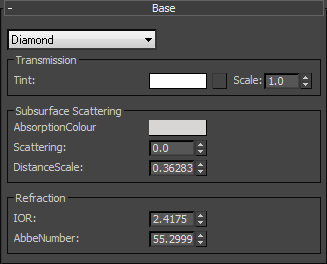
Documentation

Documentation
This component represents transparent solid objects such as cut glass or gemstones. It produces ideal (non-glossy) mirror reflections. Light is refracted as it enters and leaves the material, spectral dispersion can also be simulated (i.e. splitting refracted white light into a spectrum of colors). Light can be absorbed within the body of the material to give a thickness-dependent color tint to the material. Subsurface scattering is supported to make the interior of the material appear cloudy (e.g. impure gemstones).

A color tint that will be applied to both reflections and transmitted light. This can be a single color value or a texture map.
Input: Color
Click material thumbnail for larger view
Controls the color of the inside of the material. Light passing through will gradually be absorbed based on this color. The thicker the object, the more light will be absorbed. A pure white color means there will be no absorption, a pure black color means all light is absorbed as soon as it enters the material. This must be a single color value, it cannot be a texture map or noise function.
Input: Color
Click material thumbnail for larger view
Allows the strength of the subsurface scattering effect to be changed, without altering the strength of the absorption effect. Setting it to zero means there will be no SSS. Setting it to 1.0 gives the strongest SSS effect (for a given distance scale).
Range: 0.0 - 1.0
Click material thumbnail for larger view
This scale, in metres, controls the overall strength of the subsurface scattering and absorption effects. Reducing this parameter will strengthen the effects. On average, light passing through the material will undergo scattering and absorption each time it travels this distance through the material. Note that the useful range for the distance scale parameter is between one-tenth and ten times the size of the object the material is applied to. Setting a value outside of this range will make little or no difference to the material's appearance.
Range: 0.0 -
Click material thumbnail for larger view
The index of refraction of the material.
Range: 0.0 -
Click material thumbnail for larger view
This controls the spectral dispersion effect. Set it to zero to disable spectral dispersion. A non-zero value will enable dispersion, with the strength of the dispersion effect depending on the Abbe number in a physically realistic way. A low Abbe number leads to strong dispersion, a high Abbe number leads to weak dispersion. Types of glass are often classified according to their Abbe number - typical values range from 20 up to 85.
Range: 0.0 -
Click material thumbnail for larger view
Base
Click material thumbnail for larger view
▲Page Last Edited: